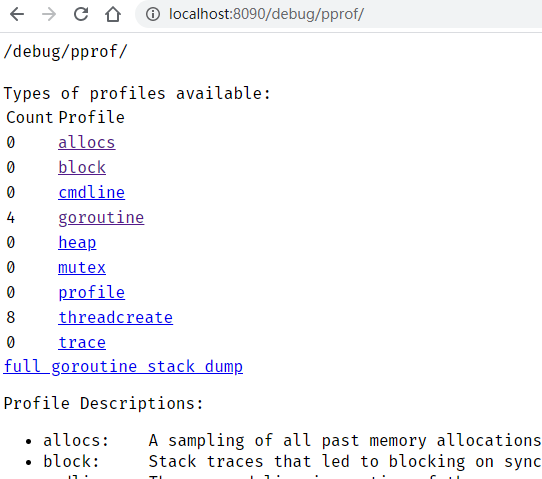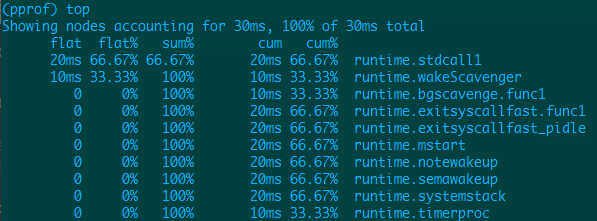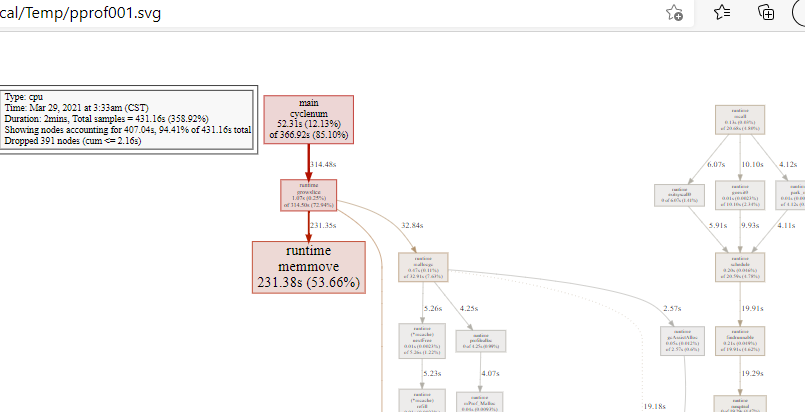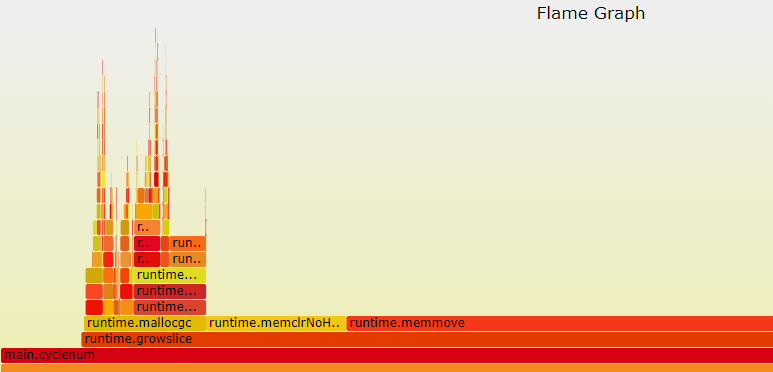golang 效能調優分析工具 pprof(下)
阿新 • • 發佈:2021-03-30
[golang 效能調優分析工具 pprof(上)篇](https://www.cnblogs.com/jiujuan/p/14588185.html), 這是下篇。
## 四、net/http/pprof
### 4.1 程式碼例子 1
> go version go1.13.9
把上面的程式例子稍微改動下,命名為 demohttp.go:
```go
package main
import (
"bytes"
"fmt"
"io/ioutil"
"log"
"math/rand"
"net/http"
_ "net/http/pprof"
"sync"
)
func main() {
http.HandleFunc("/pprof-test", handler)
fmt.Println("http server start")
err := http.ListenAndServe(":8090", nil)
if err != nil {
log.Fatal(err)
}
}
func handler(resp http.ResponseWriter, req *http.Request) {
var wg sync.WaitGroup
wg.Add(200)
for i := 0; i < 200; i++ {
go cyclenum(30000, &wg)
}
wg.Wait()
wb := writeBytes()
b, err := ioutil.ReadAll(wb)
if err != nil {
resp.Write([]byte(err.Error()))
return
}
resp.Write(b)
}
func cyclenum(num int, wg *sync.WaitGroup) {
slice := make([]int, 0)
for i := 0; i < num; i++ {
for j := 0; j < num; j++ {
j = i + j
slice = append(slice, j)
}
}
wg.Done()
}
func writeBytes() *bytes.Buffer {
var buff bytes.Buffer
for i := 0; i < 30000; i++ {
buff.Write([]byte{'a' + byte(rand.Intn(10))})
}
return &buff
}
```
### 4.2 開始分析
#### 4.2.1 在 web 介面上分析
先執行上面的 demohttp.go 程式,執行命令:
>go run demohttp.go
然後在瀏覽器輸入:[http://localhost:8090/debug/pprof/](http://localhost:8090/debug/pprof/),檢視服務執行情況,如下圖:

| 名稱 | url | 說明 |
| --- | --- | --- |
| allocs | $host/debug/pprof/allocs?debug=1 | 過去所有記憶體抽樣情況 |
| block | $host/debug/pprof/block?debug=1 | 同步阻塞時程式棧跟蹤的一些情況 |
| heap | $host/debug/pprof/heap?debug=1 | 活動物件的記憶體分配情況 |
| mutex | $host/debug/pprof/mutex?debug=1 | 互斥鎖持有者的棧幀情況 |
| profile | $host/debug/pprof/profile | cpu profile,點選時會得到一個檔案,然後可以用 go tool pprof 命令進行分析 |
| threadcreate | $host/debug/pprof/threadcreate?debug=1 | 建立新 OS 執行緒的堆疊跟蹤情況|
| trace | $host/debug/pprof/trace | 當前程式執行的追蹤情況,點選時會得到一個檔案,可以用 go tool trace 命令來分析這個檔案 |
點選上面的連結,就可以檢視具體的分析情況。
不斷重新整理網頁,可以看到資料在不斷變化。
#### 4.2.2 命令列互動分析
在命令列上執行 demohttp.go 程式,執行命令:
>go run demohttp.go
**A. 分析 cpu profile**
在開啟另外一個命令列終端,執行如下命令:
> go tool pprof http://localhost:8090/debug/pprof/profile?seconds=70

引數 seconds = 70:進行 70s 的資料樣本採集,這個引數可以根據實際情況調整。
上面的命令執行後,會等待 70s , 然後才會進入命令互動介面,如上圖
輸入 `top` 命令:

大家發現沒,其實與上面 runtime/pprof 在命令列互動時是一樣的操作,可以參考上面的欄位引數說明。
找出耗時程式碼部分,也可以用命令:`list`。
在 `top` 命令執行後,發現什麼問題沒?這個 top 命令顯示的資訊都是系統呼叫資訊耗時,沒有使用者定義的函式。為什麼?下面進行分析。
**B. 分析 memory profile**
執行命令:
> go tool pprof http://localhost:8090/debug/pprof/heap
然後同樣輸入 `top` 命令檢視函式使用情況,如下圖:

其餘的跟蹤分析命令類似,就不一一分析了。
把上面在終端命令列下互動分析的資料進行視覺化分析。
#### 4.2.3 圖形視覺化分析
##### A. pprof 圖形視覺化
在前面視覺化分析中,我們瞭解到視覺化最重要有 2 步:1.採集資料 2.圖形化採集的資料。
在上面第三節 runtime/pprof 中,進入終端命令列互動操作,然後輸入 web 命令,就可以生成一張 svg 格式的圖片,用瀏覽器可以直接檢視該圖片。我們用同樣的方法來試一試。
1. 輸入命令:
>go tool pprof http://localhost:8090/debug/pprof/profile?seconds=30
2. 等待 30s 後輸入 `web` 命令
如下圖:

果然生成了一個 svg 檔案,在瀏覽器檢視該圖片檔案,啥有用資訊也沒有,如下圖:

為什麼沒有有用資訊?前面有講到過,沒有使用者訪問 http server ,需要的程式沒有執行,一直阻塞在那裡等待客戶端的訪問連線,所以 go tool pprof 只能採集部分程式碼執行的資訊,而這部分程式碼又沒有消耗多少 cpu。
那怎麼辦?
一個方法就是用 http 測試工具模擬使用者訪問。這裡用 [https://github.com/rakyll/hey](https://github.com/rakyll/hey) 這個工具。
安裝 hey:
>go get -u github.com/rakyll/hey
安裝完成後,進行 http 測試:
>hey -n 1000 http://localhost:8090/pprof-test
同時開啟另一終端執行命令:
>go tool pprof http://localhost:8090/debug/pprof/profile?seconds=120
等待 120s 後,採集資訊完成,如下圖:

輸入 `top` 命令檢視統計資訊:

可以看到使用者定義的一個最耗時函式是:`main.cyclenum`。如果要檢視這個函式最耗時部分程式碼,可以用 `list cyclenum` 命令檢視。
我們這裡是要生成一張圖片,所以輸入 `web` 命令生成圖片:

在瀏覽器上檢視 svg 圖片:

(圖片較大,只截取了部分)
這張圖完整的展示了 `top` 命令的資訊。
##### B. web 視覺化
執行命令:
> go tool pprof -http=":8080" http://localhost:8090/debug/pprof/profile
同時開啟另一終端執行測試命令:
> hey -n 200 -q 5 http://localhost:8090/pprof-test
上面 `go tool pprof` 執行完成後,會自動在瀏覽器開啟一個 http 地址,[http://localhost:8080/ui/](http://localhost:8080/ui/),如下圖:

(擷取部分圖片)
這樣就可以在web瀏覽器上檢視分析資料了。
##### C. 火焰圖
用 http 測試框架 [hey](http://github.com/rakyll/hey) 訪問,命令為:
> hey -n 200 -q 5 http://localhost:8090/pprof-test
在壓測的同時開啟另一終端執行命令:
> go-torch -u http://localhost:8090
來生成火焰圖。
執行命令時在終端輸出了資訊 :
>Run pprof command: go tool pprof -raw -seconds 30 http://localhost:8090/debug/pprof/profile
可以看到 `go-torch` 的原始命令也是用到了 `go tool pprof`
上面這個命令預設生成了 torch.svg 的火焰圖檔案,如下:

(擷取一部分圖展示)
點選方塊可以檢視更詳細資訊:

## 參考
- [pprof](https://github.com/google/pprof)
- [README](https://github.com/google/pprof/blob/master/doc/README.md)
- [Profiling Go Programs](https://blog.golang.org/pprof)
- [runtime/pprof](https://golang.org/pkg/runtime/pprof/)
- [net/http/pprof](https://golang.org/pkg/net/http/pprof/)
- [go-torch](https://github.com/uber-archive/go-torch)
- [Flame Graph](https://github.com/brendangregg/FlameGraph)
- [http 壓測工具 hey](http://github.com/rak
